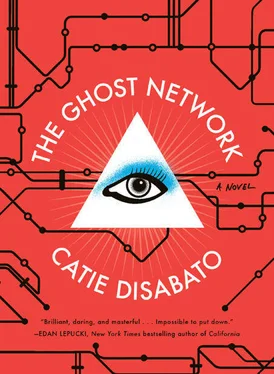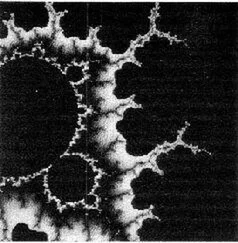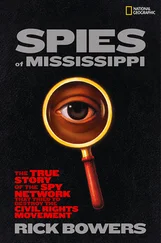In the prison’s visiting room, outfitted with various cameras and recording devices, Kraus and Berliner couldn’t speak freely about Nix’s kidnapping. They could talk for hours about maps and sex apartments and pop stars, but use phrases like “almost cut off her fingers,” and the prison guards would start to take notice. Berliner spoke as freely as he could; he could talk openly about Davis’s death at least, which he did as Kraus stroked the back of his hand.
Berliner was afraid he wouldn’t be able to fight back, he was afraid he wouldn’t find what Molly Metropolis had found, and he was afraid that he, Nix, and Taer wouldn’t be able to protect themselves from the New Society. Kraus wouldn’t let him be afraid. She held his hand and whispered ferociously to him until Berliner no longer had the urge to cry.
Taer didn’t tell Berliner and Nix about the secret train for another day and a half. She waited until she decided Nix was recovered enough — still nervous and jumpy, but able to leave the Urban Planning Committee if she carried the gun with her. Preparing for a dramatic scene, Taer brought Berliner and Nix takeout from their favorite Italian restaurant, turned on her iPhone voice recorder to continue to track the story, and attempted to combine apology and explanation while their mouths were full.
Nix and Berliner were both livid that Taer hadn’t told them sooner. Most people have a particular arguing style, developed through years of familial conflict or friend-group infighting. Taer, Nix, and Berliner all argued differently. Berliner learned from his mother to be quiet during a fight; Dana Berliner didn’t appreciate raised voices. Nix, a veteran of popular girl hierarchies, hated conflict; she made jokes to amuse herself and defuse the tension. Taer, who had three stubborn brothers, immediately became defensive.
“Why didn’t you tell me about it this morning?” Berliner asked.
“I’m not telling you anything until you calm down and listen to me.”
“I’m perfectly calm.”
“Yeah, sure,” Nix said.
“I don’t have to tell you every little thing I do,” Taer said.
“I thought we were working on this together,” Berliner said.
“I think I’ve sacrificed enough to warrant full disclosure at this point,” Nix said.
“You could’ve trusted us, maybe,” Berliner said.
“How did I know you wouldn’t have figured something out from what I found, and not told me about it? How do I know I can trust you when it really comes down to it?” Taer said to Berliner.
“Well, two nights ago, you said to me, ‘I’ve been living in your lair for two months now, and you’ve been the best friend to Nix and me. I totally trust you.’ So there’s that.”
“I meant I trusted you not to make a move on me in the night or something.”
“That place really is like a lair,” Nix said.
“Stop fucking with me,” Berliner said. “This is exactly what Metro did. Leaving cryptic messages and just fucking off.”
“I’m not doing that,” Taer said.
“It feels like you’re doing the exact same thing.”
“I wanted to find what she found. You met her, you knew her.”
“I could’ve hid this whole thing from you, but I didn’t want to do it by myself,” Berliner said. “Is that what you want?”
“No,” Taer said.
“To go at it alone?”
“No, I said,” Taer said. “Okay, okay? Let me tell you! I found some stations on the map, these little pink dots, they were just floating there, all by themselves—”
“This is exactly why you should’ve told me right away,” Berliner interrupted, “We didn’t get a chance to check everything, they might be errors—”
“Well, they’re not errors, and this is exactly why I didn’t want to tell you right away, because you’re not listening—” Taer said.
“I’m listening!”
“No, you are interrupting me when I’m trying to tell you what happened.”
“Guys,” Nix said, firmly.
“Okay, so, I think that when Molly wrote in her notebook about the Pyramid Eye, or the Third Eye, or even all that stuff with Chombart de Lauwe mapping that triangle for that girl, do you remember that?” Taer asked.
“Yeah,” Berliner said.
“When she was writing that, I think she was trying to make us think about triangles, in relation to The Ghost Network. I think she hid a triangle on there somehow, and I think I found two points on the triangle. She marked them as stations on the digital map. One of the marks is on this address, the Urban Planning Committee headquarters, so I think Molly thought of this as a metaphorical station — unless there is a train station under here, I don’t know, I don’t think so, though. Anyway, I found a second dot in the same color, and I went there.”
Taer then told Berliner and Nix the story of finding the station and running from the approaching train. As Nix and Taer discussed the train, Berliner opened MollyMaps, pursuing an idea that had been nagging at him since Taer mentioned she had found some station dots unconnected to any train lines. Berliner checked the revision history of the digital version of The Ghost Network and saw that on January 9, sometime after Molly had left the Museum of Contemporary Art, she had added a map to The Ghost Network and then deleted it. Berliner restored the deleted map. It appeared on The Ghost Network as a narrow, pale pink triangle. One apex landed at the Urban Planning Committee headquarters; the second apex was the Chicago Executive Airport, where Taer had run from the mysterious train; the third apex was at a location neither Berliner nor Taer recognized, but it intersected with a station on a train line that had never been approved by the city.
The non-approved train line would’ve been 154.8 miles long, stretching from the most affluent southern suburbs of Milwaukee all the way down to the country clubs in Chicago’s southern suburban region. The line would’ve sideswept the overcrowded Loop lines meant for businessmen and other commuters. Most of the line’s stations would’ve hugged the waters of Lake Michigan. Once it left the water, it veered into the Theater District.
The Chicago Transit Authority proposed the train line in 1957, in a project co-sponsored by the State Tourism Board. The CTA and Tourism Board designed the line not only to increase tourism to the city’s beaches but also to attract the “right kind” of tourists by stopping only in the wealthiest suburbs. ǁA Chicago Tribune reporter, writing about the tourism proposal in its entirety, dubbed the train line “The Party Line,” both referring to the leisure-based purpose of the line and mocking the city’s newly elected mayor, Richard J. Daley for ‘toeing the party line’ of his political party. aThe Party Line was supposed to be a cost-efficient line because it reused some bomb shelter/underground stations that had gone out of service in the 1940s, but when Daley and the CTA discovered that each of those underground stations would need about a million dollars in renovations before they would be up to code, the Party Line died. The plans for the line were filed with the rest of the city’s transit records. Decades later they were mined from the Public Archives by Peaches. Molly Metropolis added the Party Line to The Ghost Network on August 3, 2009.
Berliner relayed the history of the Party Line to Nix and Taer. They decided to go to the third point in Molly’s triangle the next day, in the early afternoon. They didn’t even have to take the L; the Party Line station was within walking distance of the New Situationist headquarters on North Wells Street, halfway between West North Avenue and West Schiller Street, at the site of the Old Town Aquarium, a boutique tropical fish store. The land had been privately owned by a real estate company called Rind-Grandin Global since the mid-1960s. Jim and Ian Schakowsky, brothers and world-class deep-sea divers, had first rented the property in 1972 and had been running Old Town Aquarium for nearly four decades. Although they didn’t advertise this service, the Schakowsky brothers’ elite clients could hire them to procure any aquatic life-form “physically smaller than Jim,” the taller of the two. A regular customer, who spoke to me on the promise of anonymity, has a secret collection of endangered sea life acquired for him by the Schakowskys.
Читать дальше












